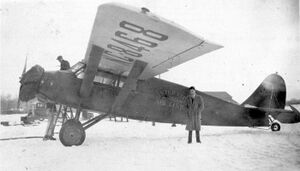Engineering:Stinson Detroiter
| Detroiter | |
|---|---|

| |
| Stinson SM-1F | |
| Role | Utility monoplane |
| National origin | United States |
| Manufacturer | Stinson Aircraft Syndicate Stinson Aircraft Company |
| First flight | 25 January 1926 |
| Number built | 100+ |
| Variants | Stinson Junior |
The Stinson Detroiter was a six-seat cabin airliner for passengers or freight designed and built by the Stinson Aircraft Syndicate, later the Stinson Aircraft Corporation. Two distinct designs used the Detroiter name, a biplane and a monoplane.
Development
The first design from the Detroit-based Stinson Aircraft Syndicate was the Stinson SB-1 Detroiter, a four-seat cabin biplane with novel features such as cabin heating, individual wheel brakes and electric starter for the nose-mounted 220 hp (164 kW) Wright J-5 Whirlwind engine. It made its first flight on Jan 25th, 1926.[1] The Harley Davidson brakes were demonstrated on a snowy maiden flight requiring wheel chains to be added to prevent skidding.[2] This aircraft was soon developed into the six-seat Stinson SM-1D Detroiter, a braced high-wing monoplane version which ultimately made quite a number of significant long-range flights.[3][4] The aircraft was soon a success and it enabled Stinson to get $150,000 in public capital to incorporate the Stinson Aircraft Corporation on 4 May 1926.[4]
Seventy-five of the Wright J-5-powered versions were built, followed by 30 Wright J-6-powered aircraft. From 1928, SM-1 aircraft were used on scheduled services by Paul Braniff's Braniff Air Lines and by Northwest Airways.[5]
In 1930 a SM-1FS with a crew of three reached Bermuda from New York City , the first flight ever to the islands. Getting there the aircraft had to land twice, once because of darkness and later after running out of fuel. With a wing strut damaged, it was shipped back to New York.[6]
In 1928 Stinson developed the smaller SM-2 Junior model to appeal to private owners.
Variants
- SB-1 Detroiter
- Original biplane version with a 220hp (164kW) Wright J-5 Whirlwind engine. 26 units built. Prototype sold to Horace Elgin Dodge, first production model sold to John Duval Dodge of Dodgeson.[7]
- SM-1D
- High-wing monoplane version with a 220hp (164kW) Wright J-5 Whirlwind engine.
- SM-1DA
- As SM-1D with detailed improvements.
- SM-1DB
- As SM-1D with minor improvements
- SM-1DC
- As SM-1D with detailed improvements.
- SM-1DD
- Freighter variant with two seats and cargo-carrying interior, one built.
- SM-1DE
- Freighter variant with two seats and cargo-carrying interior, one built.
- SM-1DX
- variant powered with a 225hp Packard DR-980 Diesel engine, one built and first diesel powered aircraft to fly.
- SM-1F
- Variant from 1929 with a 300hp (224kW) Wright J-6 engine.
- SM-1D300
- SM-1Ds modified with a 300hp (224kW) Wright J-6 engine.
- SM-1FS
- Floatplane variant of the SM-1F.
- SM-6B
- A larger capacity six-seat variant with a 450hp (336kW) Pratt & Whitney Wasp C1 radial engine, two were built followed by eight more with eight-seat interiors.
- SM-7B
- Originally powered by a 300hp (220kW) Pratt & Whitney R-985 Wasp Junior radial engine, five were built each year in 1928, 1929 and 1930. E.L. Cord's personal plane was operated for several years during/after World War II by Western Air Express with (illegally) a 450hp (336kW) Pratt; subsequently restored in 1980-2020 with a legal 300hp Lycoming R-680.[8]
- SM-8A
- Five-seat model, originally powered by a 300hp (220kW) Lycoming R-680 radial engine. Cruise 100 mph.[9]
Operators
 Republic of China
Republic of China
- China National Aviation Corporation
- China Airways Federal
- Shanghai-Chengtu Airways (1920s–30s)[10][11]
 Peru
Peru
- Faucett[12]
- Peruvian Air Force
 United States
United States
- Braniff Air Lines
- North American Airways[13]
- Northwest Airways
 Honduras
Honduras
- Three aircraft of this model were bought by Honduran Air Force (1933)
Specifications (SM-1F)
General characteristics
- Crew: 1 pilot
- Capacity: 6 passengers
- Length: 32 ft 0 in (9.75 m)
- Wingspan: 46 ft 8 in (14.22 m)
- Powerplant: 1 × Wright J-6 , 300 hp (224 kW)
Performance
- Maximum speed: 132 mph (212 km/h, 115 kn)
See also
Related development
- Faucett F-19
Aircraft of comparable role, configuration and era
References
- Notes
- ↑ Juptner, Joseph (1962). U. S. Civil Aircraft Series, Vol 1.. AERO Publishing, Inc.. pp. 74.
- ↑ John A. Bluth. Stinson Aircraft Company. p. 26.
- ↑ Juptner, Joseph (1962). U. S. Civil Aircraft Series. Vol 1.. AERO Publishing, Inc.. pp. 53.
- ↑ Jump up to: 4.0 4.1 "Stinson Aircraft Corporation". http://www.centennialofflight.gov/essay/GENERAL_AVIATION/stinson/GA2.htm.
- ↑ Davies, 1998, p. 734
- ↑ UNUSUAL PLACE – UNUSUAL STORY – HEROIC CREW
- ↑ John A. Bluth. Stinson Aircraft Company. p. 27.
- ↑ Blancolirio, Juan: "1930 Stinson 'Detroiter' Maiden Flight after 40 Years," August 2020, YouTube, retrieved May 20, 2023
- ↑ "About the Stinson SM8A 'Detroiter'," Port Townsend Aero Museum, retrieved May 20, 2023
- ↑ "CNAC History". http://www.cnac.org/history01.htm.
- ↑ "Stinson Detroiter". 12 December 2010. http://gregcrouch.com/2010/stinson-detroiter.
- ↑ "Airlines of the World: The Americas – Cia de Aviacion Faucett" (PDF). Flight: 420. 28 April 1938. http://www.flightglobal.com/pdfarchive/view/1938/1938%20-%201206.html. Retrieved 1 March 2012.
- ↑ "Airliners of North America". Aerofiles. http://www.aerofiles.com/airlines-am.html.
- Bibliography
- Davies, R.E.G. (1998). Airlines of the United States since 1914. Smithsonian Institution Press. ISBN 1-888962-08-9.
- Taylor, Michael J. H. (1989). Jane's Encyclopedia of Aviation. London: Studio Editions.
- The Illustrated Encyclopedia of Aircraft (Part Work 1982–1985). Orbis Publishing.
- Simpson, R.W. (1991). Airlife's General Aviation. England: Airlife Publishing. ISBN 1-85310-194-X.
External links
- aerofiles
- "The Stinson-Detroiter: An American Commercial Cabin 'Plane". Flight XVIII (19): 283–284. May 13, 1926. http://www.flightglobal.com/pdfarchive/view/1926/1926%20-%200329.html. Retrieved October 16, 2012.
 |



